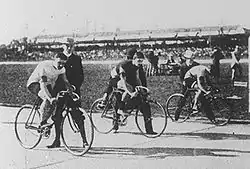 The final sprint at the 1900 Olympics: Albert Taillandier (France), Fernand Sanz (France) and John Henry Lake (USA) | |||||||||||||||
| Personal information | |||||||||||||||
|---|---|---|---|---|---|---|---|---|---|---|---|---|---|---|---|
| Born | July 27, 1877 Staten Island, New York, USA | ||||||||||||||
| Height | 172 cm (5 ft 8 in) | ||||||||||||||
Medal record
| |||||||||||||||
John Henry Lake (born July 27, 1877, date of death unknown) was an American racing cyclist who competed in the late 19th century and early 20th century. He was born in Port Richmond, Staten Island. He participated in Cycling at the 1900 Summer Olympics in Paris and won the equivalent of the modern bronze medal in the men's 2 km sprint. (The current gold-silver-bronze medal format was introduced in 1904.) He also competed in the 25 km race, but did not finish.[1][2]
In 1900 Lake invented a machine that allowed him to ride his bike on a stand that, with the help of a partner, would grind the blades of skates.[3]
References
- ↑ "John Lake Bio, Stats, and Results". Olympics at Sports-Reference.com. Archived from the original on July 2, 2017.
- ↑ "John Henry Lake". Olympedia. Retrieved 25 December 2020.
- ↑ Makes Training Pay, Greensburg Daily Review, February 23, 1900
External links
- John Henry Lake at Cycling Archives
- John Henry Lake at Olympedia
This article is issued from Wikipedia. The text is licensed under Creative Commons - Attribution - Sharealike. Additional terms may apply for the media files.